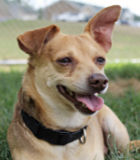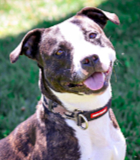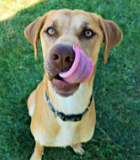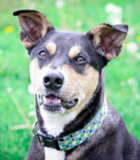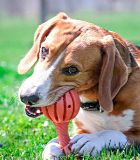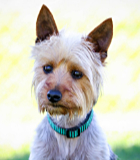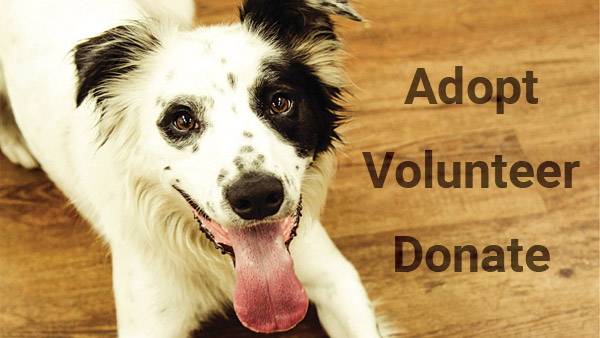Impulse Control Training and Games for Dogs
- This topic has 0 replies, 1 voice, and was last updated 13 years, 10 months ago by
Mackenzie’s Admin.
-
AuthorPosts
-
June 17, 2010 at 5:26 pm #544
Mackenzie’s Admin
MemberIn human psychology, impulse control refers to people’s ability to delay gratification or resist their immediate desires, impulses or temptations that could harm them or others. In short, impulse control means self-control or self-restraint. Babies have no impulse control, but they learn it from their parents and environment as they develop.
Dogs are similar to babies. They have no idea that they can’t have things they want right when they want them and can’t do everything they want right when they feel the urge. Most dogs need to learn to control or inhibit their behavior. With small puppies, it’s relatively easy for us to prevent undesirable behaviors—like chewing furniture or running off in pursuit of a nice scent—simply by picking them up. But as they grow larger and become more independent, it’s difficult to prevent their inappropriate behavior if they haven’t been taught to control their impulses.
The general goal of all dog training is to teach our pets impulse control. We want them to resist their immediate desires and, instead, comply with our cues or commands. Accomplishing this allows us to keep our pets under control, ensuring their safety and comfort, as well as the safety and comfort of others. For example, dogs who have been taught to come when called or to wait a moment for permission to go through doors can be kept safe from many dangers, such as getting lost or hit by cars. Likewise, dogs who have been taught to sit politely to greet people won’t jump up and injure or upset them.
Following are some training exercises and games to help you teach your dog useful “impulse control” skills such as Wait, Stay, Settle and Leave It. As with all training, you want to make sure your dog is able to succeed easily in the beginning and then gradually present more challenging situations. For more information on other training topics related to impulse control, please see our articles entitled Charging Through Doors, Teaching Your Dog to Wait at Doors, Teaching Your Dog to Come When Called, Teaching Your Dog to “Leave It,” Teaching Your Dog to Stay, Teaching Your Dog to Play Tug-of-War and Teaching Your Dog to Sit.
Leave It
If you’ve already trained your dog to leave things alone, try this fun Leave It trick. You’ll impress your friends with your dog’s fantastic impulse control! (Please see our article, Teaching Your Dog to “Leave It,” to review the basic steps.)Start with your dog in a down position as you sit or kneel in front of him. Tell him “Leave it,” and then place a biscuit on his front paw. Keep your hand in the air, hovering a few inches away from the biscuit so that you’re ready to quickly cover it up with your hand if your dog tries to eat it.
If your dog leaves the biscuit alone for one second, say “Take it!” Motion to the biscuit and let him eat it off his paw. If your dog tries to eat the biscuit before you say “Take it,” quickly cover it with your hand. Wait until he stops trying to get at the biscuit and pulls his head back, away from your hand. When he does this, you can remove your hand again. If your dog leaves the uncovered biscuit alone for one second, say “Take it!”
Practice this sequence for several days. When your dog consistently waits until you say “Take it,” to eat the biscuit, you can start to gradually stand up. Practice several days with you squatting in front of your dog. You’ll be a little further away but still ready to cover that biscuit if he goes for it before you say “Take it!” Then practice another several days with you standing but bent over so that you can still reach down quickly to “save” the biscuit. Finally, tell your dog to “Leave it,” stand up straight and place the biscuit on his paw. Hopefully, he won’t try to steal it before you say “Take it,” but if he does, you can gently but quickly cover it with your foot.Some trainers and pet owners like to play this game to the ultimate level: they place not just one biscuit on one paw, but line up several biscuits on both paws and forelegs. It’s pretty impressive to have a dog who’s got two rows of tempting treats right under his nose but doesn’t eat them until you say “Take it”!
Fetch with Wait
If your dog already knows how to play fetch, you’re ready to add a challenge: Your dog must wait until you give the okay for him to run and retrieve the toy—after you’ve thrown it. (Please see our article entitled Teaching Your Dog to Play Fetch to review the basic steps.)Start with your dog standing or sitting at your side. Hold a toy in one hand and your dog’s leash in the other to prevent him from bolting forward.
Tell your dog “Wait,” and then drop the toy so that it falls, at most, a foot away.
If your dog waits for one or two seconds without pulling toward the toy, say “Get it!” Then release him and encourage him to fetch the toy. If your dog struggles to get to the toy instead of waiting—which most dogs will—gently insist that he stay put by continuing to hold his leash. The instant he stops struggling against the leash, say “Get it” and release him to get the toy.Troubleshooting tip If your dog lunges toward the toy and seems intensely focused on it, you may need to redirect his attention toward you. While continuing to hold his leash, step in front of your dog so that you’re facing him and your body is blocking his view of the toy. Wait until he stops struggling to see or get to the toy. The instant he stops pulling toward the toy and looks at you, reward him by saying “Get it” and release him to get the toy.
After your dog grabs the toy, encourage him to bring it back to you. When he does, praise him and give him a treat. Then restart the sequence. (If your dog’s a fetching maniac, you may not need to treat him at all. Restarting the game might be rewarding enough.)
After a few days of practice, repeat the sequence above—but don’t hold your dog’s leash. Keep it attached to him and let it drag on the ground instead. This way, you’ll be able to grab or step on it to prevent him from getting to the toy if he goes for it before you release him with “Get it!”After several more days of practice and many repetitions, start to toss the ball a short distance instead of just dropping it. Say “Wait,” toss the ball about two feet away, count to three, and then release your dog with “Get it!”
When your dog is successful at waiting when you toss the toy just two feet away—for example, he waits for 9 out of 10 repetitions—you can throw the toy a few feet further. Continue to toss at that distance until your dog is about 90% successful, and then increase the distance again.
Finally, over a couple weeks of practice, you can gradually increase the length of time your dog has to wait. Start with two seconds until he’s good at that. Then increase to five seconds until he’s good at that, then increase to 10 seconds, and so on. A general guideline for lengthening Wait or Stay is to avoid always making it harder. Instead, randomly throw in easy, short repetitions to keep your dog guessing and having fun. For example, when you’re practicing the Fetch with Wait game with your dog, throw in some easy two-second Waits every once in a while so that he doesn’t get discouraged and give up.
WatchThis impulse control exercise teaches your dog that staring at a toy or treat in your hand gets him nothing, but looking at you gets him the prize! Over time, he learns to look to you for things he wants rather than just grabbing them himself.
Show your dog a toy or treat in your hand. Then ask him to “Watch!”
Hold the toy or treat still and wait for your dog to look at you, even if it’s initially just a flicker of his eyes toward you.
The instant he glances up at your eyes, say “Yes!” and give your dog the treat or throw the toy for him to chase.Over days of practice and many repetitions, gradually increase the length of time your dog has to look at you before you throw him the toy or give him the treat. Start with one second until he’s good at that, then increase to three seconds until he’s good at that, then five seconds, and so on. Be sure to randomly throw in easy one-second Watches so that your dog doesn’t get discouraged.
Gradually up the ante. Use more exciting toys, use more exciting treats or hold the treat closer to your dog’s face.Variation Like you did with Fetch with Wait, start with your dog in a sit and then toss the toy or treat. This time, ask him to “Watch” (look into your eyes) before you release him to get it.
Settle
We all want a dog who can stay settled in one spot for long periods of time and resist his impulse to get in the middle of all the distractions around him. Settle is a useful dog skill when you’re eating dinner, when you have a friend over or when you’re watching television. It’s basically a long-term Down-Stay in one spot, like on a mat, a rug or a dog bed. Since you’ll probably want your dog to settle for more than just a couple of minutes, though, it’s only fair to give him some freedom of movement so that he can stay comfortable. You’ll let him readjust his position, circle and resettle, or roll on his side—as long as he stays in his special spot. Here’s how to teach him:Tell your dog to “Go to bed,” put a treat right in front of his nose, and lead him to his mat. When all four paws are on the mat, praise him, and then tell him “Down” and “Stay.”
Count to two in your head. If your dog stays in the Down, say “Good!” and give him the treat.After he’s eaten, release him with “Okay!” to let him know his job is done. Encourage him to move off of the mat by clapping your hands or walking a few steps away. Once your dog has moved, you’re ready to repeat the exercise from the beginning.
Practice this sequence for several days, and then stop using the lure (the treat in front of your dog’s nose). Instead, just use your hand motion to guide your dog to the mat and into a Down.When your dog can consistently go to his mat, lie down and stay there for two seconds, start gradually increasing the length of time you expect him to stay on the mat. This will take many repetitions over many days. From two seconds, increase the Stay to five seconds, then to 10 seconds, then 30, then one minute, five minutes, 10 minutes, a half hour, an hour, and so on.
Troubleshooting tip Be sure to randomly throw in repetitions with easy, short Stays so that your dog doesn’t get discouraged.
Additional Settle Tips
Reward your dog for his good work! When he’s first learning, be generous and reward him frequently—every 5 or 10 seconds. Once he’s getting the hang of it, you can gradually reduce the number of treats you give during his Settle.
Set your dog up for success by practicing Settle when he’s well exercised and calm.
Resist the urge to repeat the cue “Stay.” Just say it once at the beginning. Remember to always release your dog from his Settle with “Okay.” You don’t want him deciding when it’s time to get up.Practice in places where it’s useful to have your dog settle for a while. For example, if you’d like your dog to eventually settle on his mat while you eat dinner or watch TV, practice in the rooms where you eat and watch TV.
Walk & Settle
Turn your on-leash walks together into impulse-control training walks. You won’t make the entire walk an exercise in impulse control, but you can use parts of your walk to help your dog learn to control himself. During the walk, switch between the following:Require that your dog not pull on the leash for several minutes of walking
Let your dog pull and sniff to his heart’s content for a couple of minutes
Ask your dog to do a Down-Stay (Settle) for a couple of minutes while you sit on a bench or on the grass with himDoing these things when on walks will help teach your dog a number of desirable skills, including calming down and paying attention to you—even outdoors, amidst many distractions and temptations. Here’s a sample training sequence for Walk & Settle for you to try:
Walk nicely With a pocketful of treats, leave your house and give your dog your loose-leash walking cue that means he’s not allowed to pull, for example, “Let’s go!” (For detailed information on loose-leash walking, please see our article Teaching Your Dog Not to Pull on Leash.) Walk a few blocks like this, making sure to praise and occasionally treat your dog for walking without pulling. It’s tough work because, to dogs, we’re slow pokes and we walk in boring straight lines!
Pull and sniff Now give your dog a release cue that lets him know he’s on a break and can pull and sniff, for example, “Okay!” or “Free!” If you have an extendable leash, like a Flexi or a WalkAbout™ retractable leash, this is a good time to attach it and release the brake to give your dog the full length.
Settle down now After a few more blocks of letting your dog pull and sniff, look for somewhere you can sit down, like a park bench, a low wall or some soft grass. Have a seat and ask your dog to lie down and stay. This could be a challenge the first few times because your dog’s not accustomed to lying down calmly in the middle of walks! You might initially need to use your leash to enforce his Down-Stay. (Hold the leash or step on it with your foot.) Be patient and gently insistent. While your dog’s staying, be sure to reward him frequently with treats and praise. Once the two of you have chilled out for a couple of minutes, say “Let’s go,” and restart loose-leash walking.
Cycle through these segments as many times as you like during your walks, in the order shown above. After you’ve trained for several weeks and your dog has the hang of it, surprise him occasionally by mixing up the order of these segments during your impulse-control training walks.Ready-Set-Down!
Here’s a fun game that also trains your dog to hear and obey you even when he’s excited and playful. You’ll need space to run, so try this in your fenced yard or another large, safe area.Start with your dog in a Sit-Stay or Down-Stay next to you. Crouch a bit as if you’re at a runners’ starting line, with your hand on your dog’s collar to help hold him in position if necessary.
Rev your dog up a bit with excited talk, like “Are you ready? Are you ready, boy?” Then say “Ready, set, GO!” and burst into a run, encouraging your dog to run alongside you.
After about five strides, prepare your dog for the next step. As you continue running, say “Ready, set, DOWN!” and then immediately stop. If your dog lies down, praise him happily and give him a treat. If he doesn’t, lure him into a down with a treat the first few times you practice this, and then reward him.
Start the sequence again. As he’s lying there, crouch next to him and rev him up. Then say “Ready, set, GO!” and run with him. After running several strides, say “Ready, set, DOWN!” and treat him for lying down.
For variation, throw in other behaviors that your dog knows instead of Down. Try “Ready, set, SIT!” and “Ready, set, ROLLOVER!”
After you’ve played this game for a few weeks and your dog’s got the hang of it, you can stop treating him for the Down (or Sit or whatever). Instead, getting to run again with you becomes the reward.Airplane Sit-Stay
Remember when you were a little kid and your parents “flew” a spoon full of food into your mouth? (“Here comes the airplane, into the hangar!”) You can play a variation of this fun little game with your dog! It will build his Sit-Stay by teaching him that it pays to wait patiently for good things to come to him—even when he thinks he could snatch them for himself. To start, put a treat in your hand and hold it behind your back.Begin by asking your dog to sit and stay in front of you.
Now take your treat hand out from behind your back and hold it about three feet above your dog’s head. He should be staring up at the treat in the air. Then start to lower the treat fairly quickly, straight down toward your dog’s nose. (It should take you three seconds at most to “fly” the treat down to his nose.)
If your dog starts to leap into the air to get the treat as soon as you bring it out from behind your back, just stand completely still. Continue to hold the treat in your hand, way up above your dog’s head and out of his reach. Calmly ask him to sit and then wait patiently until he does. As soon as he sits, proceed with the game.
If your dog stays seated while the treat descends, praise him and keep lowering the treat toward his nose. As long as your dog’s still sitting, you can finally put it right into his mouth.
If your dog jumps up and tries to snatch the treat before it reaches his mouth, quickly reverse directions with your treat hand and zoom it straight back up to its original starting point. Holding the treat about three feet above your dog’s head again, ask your dog to sit and stay. The instant he sits, begin lowering the treat again, straight down toward his upturned nose. Keep repeating the immediate consequence of flying the treat straight back up and out of reach the instant your dog breaks his Sit-Stay—until he stays seated the entire time the treat’s on its way down to him.The message to your dog: If you stay seated, the treat keeps coming down toward you, straight into your mouth. If you pop out of your Sit-Stay, the treat zooms up and away, out of your reach. It pays to patiently wait!
When your dog can hold his Sit-Stay until you deliver the treat right into his mouth 9 out of 10 times, you can make it a little harder by slowing down your “airplane” delivery. Instead of lowering the treat down to your dog’s mouth within three seconds, slow down a bit and deliver it in five seconds. This slower delivery will tempt your dog to jump up to get the treat. He’ll quickly relearn, though, that the treat flies up and away the instant he breaks his Sit-Stay. Over days of practice and many repetitions, gradually stretch out your airplane delivery to 10 seconds.
Sit-Stay for the Leash
It can be frustrating to attach your dog’s leash to his collar when he’s bouncing around uncontrollably. The following practical game teaches your dog to have a little self-restraint, even when he’s anticipating a walk—which is one of the highlights of his day!Get out your leash and wait until your dog is calm enough to listen to you.
Ask him to sit and stay. Then start to bring the leash clip toward his collar so that you can clip it on.The instant he gets up and breaks his Sit-Stay, say “Oops!” and put the leash behind your back. (Aim for sounding disappointed rather than angry. You don’t want to scare your dog. You just want to tell him that he blew it the instant he stood up.) Ask him to sit again and calmly wait until he does.
The instant he’s sitting, start bringing the leash clip toward his collar again to clip it on. If he stays seated, great. Clip on the leash and release him from his Sit-Stay with “Okay, let’s go.” Then go on your walk. If your dog doesn’t stay seated, say “Oops!” the instant he gets up, and repeat the immediate consequence of withdrawing the leash and putting it behind your back. Repeat this leash-disappearance act as many times as needed for your dog to get the idea that breaking his Sit-Stay makes the leash go away.
Don’t become impatient with your dog’s early mistakes. He’s learning a difficult task! With your quick and consistent consequences for breaking his Sit-Stay, he’ll soon be a pro at sitting still while you attach his leash. -
AuthorPosts
- You must be logged in to reply to this topic.



